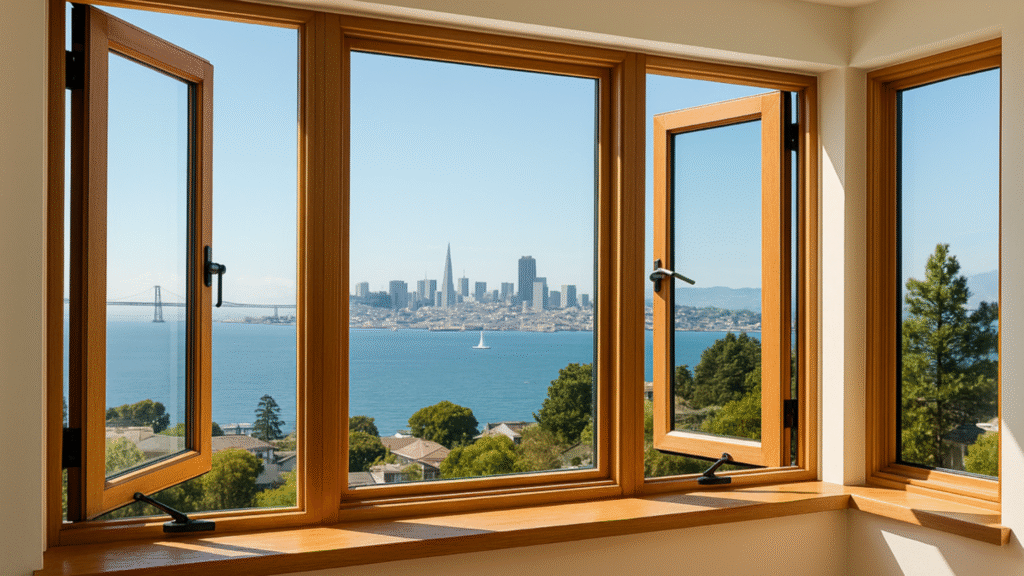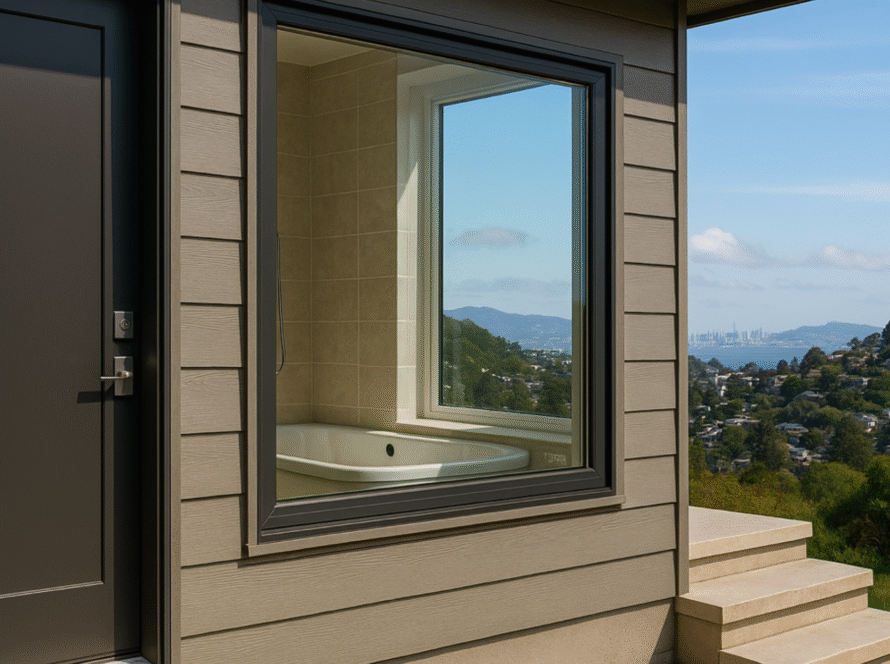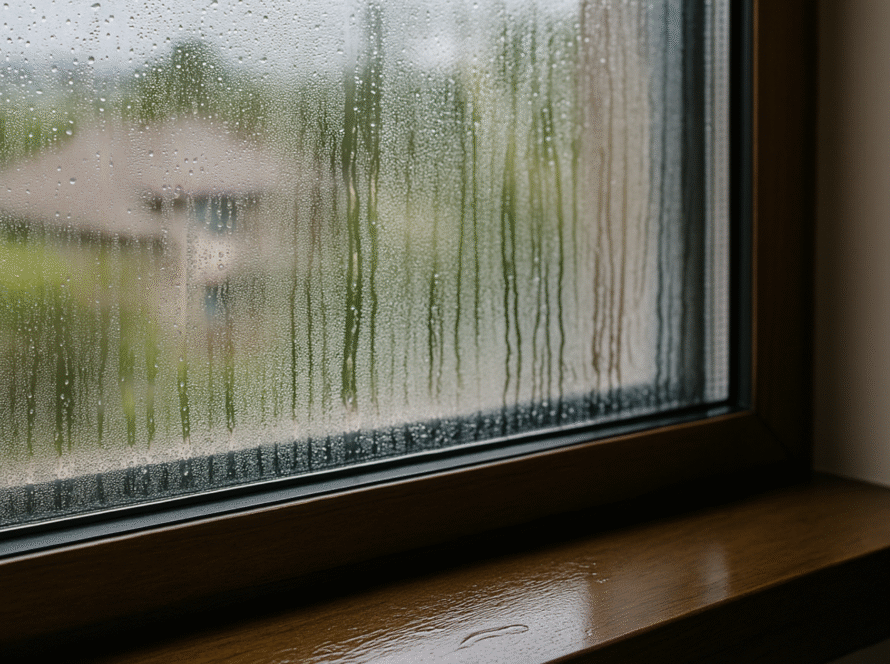
What is a casement window? Learn how these hinged windows enhance ventilation, energy efficiency, and modern style in Bay Area homes.
Understanding Your Window Options
What is a casement window, and why do Bay Area homeowners choose them? A casement window is a window that’s hinged on one side and swings open like a door, operated by a crank handle. Unlike traditional windows that slide up and down or side to side, casement windows open outward from the window frame to provide maximum airflow and unobstructed views.
These side-hinged windows have become increasingly popular across Benicia and the broader San Francisco Bay Area. The unique design allows homeowners to direct cool ocean breezes into their homes while maintaining the tight seal needed to keep out coastal fog and moisture when closed.
Casement windows open by turning a crank handle located at the base of the window. This mechanism pushes the window sash outward, similar to opening a door. The hinges at the side of the frame allow the window to swing open up to 90 degrees, creating a clear opening for air circulation.
What Makes Casement Windows Different
Side-Hinged Design and Operation
The defining feature of a casement window is its side-mounted hinges. This window type operates on a vertical axis rather than the horizontal movement of sliding windows or the vertical motion of double-hung windows. The hinges at the side create a door-like function that sets casement windows apart from other types of windows.
When you turn the crank handle, gears engage to push the sash away from the frame. This outward-opening design means screens must be placed on the interior of the window. Most homeowners find this arrangement protects screens from weather damage while making them easier to remove for cleaning.
Energy Efficient Performance
Casement windows offer superior energy efficiency compared to many window styles. When closed, the sash presses firmly against the frame, compressing weatherstripping to create an airtight seal. This compression seal blocks drafts more effectively than windows that simply meet at a track or overlap.
For Bay Area homes dealing with temperature swings between foggy mornings and sunny afternoons, this tight seal helps maintain consistent indoor comfort. The energy-efficient design reduces heating and cooling costs by preventing conditioned air from escaping through gaps around the window frame.
Maximum Ventilation Control
The ability to open and close casement windows to precise angles gives homeowners exceptional control over airflow. You can catch cross breezes by positioning windows to funnel air through your home, or crack them slightly for gentle ventilation without fully exposing your interior.
This matters in microclimates throughout the Bay Area, where you might want full ventilation on warm days in Benicia but only partial opening when coastal winds pick up. The crank handle lets you easily adjust the opening width, even in hard-to-reach areas above kitchen sinks or countertops.
How Casement Windows Work
Crank Handle Mechanism
The crank handle sits at the bottom corner of the window, typically around waist height for easy access. When you turn the handle clockwise, a system of gears and arms extends, pushing the sash outward. Turn it counterclockwise to pull the window back and secure it closed.
This mechanical advantage means you don’t need to lift heavy sashes or struggle with sticky tracks. The gears do the work, making opening casements simple, even for windows installed high on walls or in awkward positions.
Ready to upgrade your Bay Area home with high-performance windows? Contact the best replacement window contractors for a free consultation on casement and other energy-efficient window options.
Locking and Sealing
When fully closed, a multi-point locking system engages along the sash edge. These locks pull the window tight against the frame while the internal mechanisms press the sash into the weatherstripping. This creates the energy-efficient seal that makes casement windows effective at blocking air infiltration.
The locking mechanism also provides security benefits. Multiple lock points distributed along the frame make casement windows harder to force open from the outside than single-lock window styles.
Benefits of Casement Windows
Unobstructed Views and Natural Light
The single-sash design means there’s no center rail or meeting point blocking your view. When you look through a casement window, you see clear glass from top to bottom. This makes them excellent choices for capturing views of Bay Area landscapes or letting maximum natural light into darker rooms.
Easy Cleaning and Maintenance
Most casement windows can swing open to nearly 90 degrees, giving you full access to both sides of the glass from inside your home. This is particularly valuable for second-story windows or hard-to-reach exterior walls where cleaning from outside would require a ladder.
You can wipe down the exterior glass, clean the window frame, and inspect weatherstripping without leaving your room. This convenience means Bay Area homeowners are more likely to keep windows clean and well-maintained.
Modern Aesthetic Appeal
Clean lines and minimal framing give casement windows a contemporary appearance that complements modern and traditional architecture. The vertical orientation fits well in narrow spaces between kitchen cabinets or in bathrooms where wall space is limited.
Many homeowners who choose the best replacement windows choose casement styles to update older homes while improving functionality and curb appeal.
Weather Resistance
The compression seal formed when casement windows close makes them particularly effective at keeping out wind-driven rain. This matters during Bay Area storm seasons, when windows are exposed to both moisture and pressure from gusty winds. The sash pressing into the frame prevents water infiltration better than windows relying on overlapping panels or track systems.
Casement Windows vs Other Window Types
Casement vs Double Hung Windows
A double-hung window has two sashes that slide vertically within the frame. You can open either the top or bottom sash, or both partially, for ventilation. This vertical sliding motion differs fundamentally from the outward-opening mechanism of casement windows.
While double hung windows work well in many applications, they typically don’t seal as tightly as casement windows. The sliding mechanism requires small gaps that can allow air infiltration. However, double hung windows don’t project outward, making them better choices near walkways, decks, or patios where an outward-swinging window might create an obstruction.
Casement vs Sliding Windows
Sliding windows move horizontally along a track, similar to a sliding glass door. They’re simple to operate and work well for wide openings where you want a contemporary look. However, only half the window opens at once, since one panel must remain stationary while the other slides past.
Casement windows open fully, providing 100% of the window area for ventilation. The seal is typically tighter because casement windows press into weatherstripping rather than gliding along tracks that accumulate dirt and wear over time.
Casement vs Awning Windows
Awning windows are essentially casement windows turned on their sides. Instead of hinges at the side, awning windows have hinges at the top and open outward from the bottom. This creates an awning effect that sheds rain while allowing ventilation.
Both window styles use similar hardware and provide good energy efficiency. The choice often comes down to the specific application. Awning windows work well above doors or in bathrooms where you want ventilation without compromising privacy. Windows hinged at the side (casement style) fit better in standard wall openings where vertical orientation makes sense.
When Casement Windows Work Best
Bay Area Climate Considerations
The San Francisco Bay Area’s unique microclimates make casement windows particularly valuable. The ability to precisely control ventilation helps manage indoor comfort in fog, sun, and wind. You can open windows wide on clear days to flush out stale air, then seal them tight when coastal moisture rolls in.
The energy-efficient seal also helps with Bay Area energy codes. California’s Title 24 requirements emphasize reducing heating and cooling loads. Casement windows’ superior air-sealing helps homes meet these standards while lowering utility costs.
Ideal Room Applications
Casement windows excel in specific locations throughout your home:
Kitchens: Install above-sink cabinets so the crank handle remains accessible despite countertops and faucets. The outward opening doesn’t interfere with cabinet space or appliances.
Bathrooms: Provide ventilation without sacrificing wall space. The tall, narrow proportions fit well in bathroom layouts, while the easy operation means you’ll actually use them for moisture control.
Bedrooms: Capture cross-breezes for natural cooling. Position casement windows on opposite walls to create airflow that reduces reliance on air conditioning during mild weather.
Living Areas: Frame views with unobstructed glass. The clean sightlines enhance your connection to outdoor spaces while flooding rooms with natural light.
Home Offices: Control ventilation for comfort during long work sessions. Crack windows slightly for fresh air without creating distracting drafts or noise.
Design and Installation Considerations
Consider the window’s swing direction when planning casement window placement. Windows that open outward need clearance on the exterior. Avoid locations where opened windows would block walkways, interfere with outdoor furniture, or swing into plantings.
Think about wind patterns around your property. In the Bay Area, prevailing winds often come from specific directions. Position casement windows to catch desirable breezes or angle them away from strong gusts that might strain hinges or slam windows shut.
The window style you choose should complement your home’s architecture. Casement windows pair well with contemporary designs but also work in traditional settings, especially when configured in groups or combined with fixed picture windows for larger openings.
Choose the Right Windows for Your Bay Area Home
Casement windows combine energy efficiency, ventilation control, and modern aesthetics into a package that works well for Bay Area conditions. The side-hinged design with crank handle operation offers practical benefits for everyday use, while the compression seal delivers performance that meets California’s energy standards.
Understanding what a casement window is and how it compares to other types of windows helps you make informed decisions about window replacement or new construction projects. The key is matching window features to your specific needs, taking into account factors such as room function, architectural style, and local climate.
When you’re ready to explore window options for your Benicia or Bay Area home, work with experienced professionals who understand both the products and the regional requirements. Quality installation matters as much as the windows themselves for achieving the performance and longevity you expect.
Talk to local window experts about whether casement windows fit your project goals. The right windows enhance comfort, reduce energy costs, and improve your home’s appearance for years to come.
Since 1987, Insight Glass has provided top-quality windows & patio doors in the Bay Area.
Call 707-746-6571 for Expert Installation!
CONTACT US TO GET A FREE ESTIMATE!


